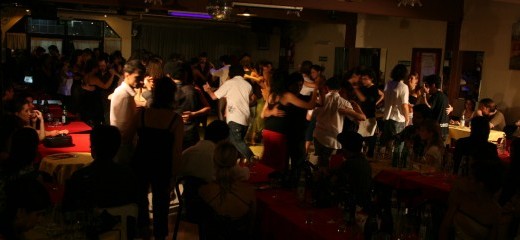
Tango Nuevo: What Is “Authentic” Tango Anyway?
by Kalila Kingsford Smith
Tango, you say? My thoughts wander first to Piazolla and then to popular images such as the tango scene in Moulin Rouge (2001) – a woman is violently passed from one man to another, thrown into turns, and caught in a dip, suspended by the strength of her male partner. In her new book Tango Nuevo, Carolyn Merritt* conjures a completely different image of tango: a calm embrace where “like much of life, the dance is about improvisation within structure.” Examining the scope of Argentine tango from its birthplace (in early 1900s Buenos Aires) to its current global popularity, Merritt probes the emergence of a new trend: tango nuevo. A wonderfully engaging ethnography, Tango Nuevo guides us on a journey through identity investigation, physical frustration, and cultural confusion as we encounter the nostalgic world of tango.Approaching Argentine tango as both an anthropologist and a dancer, Merritt dives into a continually evolving social dance form while also revealing the complexities of the global culture of tango. Drawn into tango’s therapeutic embrace in 2002, she discovered “a place where people are truly seeing, listening, and understanding one another—free of the prejudices and judgments humans are so prone to.” Merritt pulls her ethnography from her experiences as a student in the US and as a resident of Buenos Aires from 2005-2007. She attended practice sessions, social gatherings, tango festivals; she interviewed her fellow tangueros (tango dancers); she collected information from tango websites and blogs; and she tracked tango’s historical changes through archives and literature, weaving all of these elements into a beautifully crafted account of what it means to be true to tango.
When an art form becomes categorized as “new” or “contemporary,” it starts to raise questions about which version is “real” or “authentic.” Traditionalists argue that tango nuevo is not actually tango. It is too “acrobatic,” the embrace is too wide, there is no connection between the dancers. However, these “nuevo” dancers dispute the label and claim that they are not only dancing tango but also building their movement on tango’s traditional element of innovation. As Merritt shapes the arguments of both, the distinction between “traditional tango” and “tango nuevo” begins to dissolve and reveal a more interesting question about authenticity.
Merritt demonstrates that there are many people who claim they have the right to define what is authentic and what is not. Of these people, foreign travelers in Buenos Aires often feel the most entitled to the “authentic tango experience.” Paradoxically, the way they define authenticity is by the absence of foreigners like themselves. As a frequent traveler, I too have caught myself judging the quality of the “authenticity” of my encounters, so Merritt’s discussion struck a chord. Conversely, one Argentine professional argues that foreign women arrive “fascinated, in another world,” and this makes them better partners, more open to feeling the “authentic” emotion of tango. Each interview reveals a different opinion about authenticity, and Merritt moves through these perspectives without judgment, allowing the readers to do their own synthesis of the complexity of the tango experience.
I came away feeling very influenced by this theme of authenticity. A popular topic in anthropology and in the arts, the question of authenticity caused me to dive into hours of reflection about my encounters as both a traveler and as a performer. How many times have I attended a dance performance and come away thinking, “It was good, but it didn’t feel authentic.” What are the identifiers of authenticity? How does an individual recognize authenticity? What is the value of having an authentic experience? Merritt approaches all of these questions in her ethnography and essentially lands on this last one to suggest reasons for the desire for authenticity in an increasingly interactive global world. Tango Nuevo walks with finesse through the many complex twists and turns of the tango life. It is a must read for performers and travelers alike who wish to consider the many emerging questions of what it is to be part of a global community.
Carolyn Merritt, Tango Nuevo, University of Florida Press, 2012.
*Carolyn Merritt also writes for thINKingDANCE.
By Kalila Kingsford Smith
January 24, 2013






